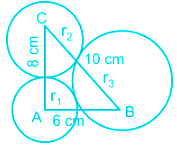Solutions
Given:
AB = 6 cm, BC = 10 cm, CA = 8 cm
Concept:
Pythagoras theorem: In a right-angled triangle,
Hypotenuuse2 = Base2 + Perpedicular2
Calculation:
We have, AB = 6 cm, BC = 10 cm, CA = 8 cm
Using Pythagoras theorem,
AB2 + AC2 = 62 + 82 = 36 + 64
⇒ AB2 + AC2 = 100 = BC2
Therefore, Δ ABC is right-angled triangle with ∠A = 90°

Let the radii of the circles with A, B and C as centres be r1, r2 and r3 respectively.
According to the given information,
AB = 6 cm = r1 + r3 ----(1)
BC = 10 cm = r2 + r3 ----(2)
CA = 8 cm = r1 + r2 ----(3)
Adding equations (1), (2) and (3),
⇒ 2(r1 + r2 + r3) = 24
⇒ r1 + r2 + r3 = 12 cm ----(4)
From (1), (2), (3) with (4) one by one we get
⇒ r1 = 2 cm, r2 = 6 cm, r3 = 4 cm
Now, Area of sector with centre A (P) = (90°/360°) × π (r1)2
⇒ (1/4) × π (2)2
⇒ π, Hence condition 1 is correct
Now, Area of sector with centre B (Q) = (θ/360)π (4)2
And Area of sector with centre C (R) = [(90 - θ)/360]π (6)2
The value of 9Q + 4R = 9 × 16πθ /360 + 4 × 36(90 - θ)π/360
⇒ 9Q + 4R = 144π [ θ + 90 - θ]/360
⇒ 9Q + 4R = 36π cm2 Hence condition 2 is also correct
∴ The option 3rd is correct.



 Get latest Exam Updates
Get latest Exam Updates 





 ×
×






